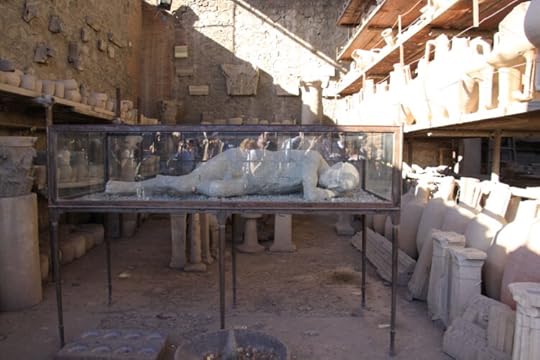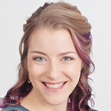L.E. Carmichael's Blog, page 16
January 29, 2021
Managing Information: Note-taking Tips for Writers
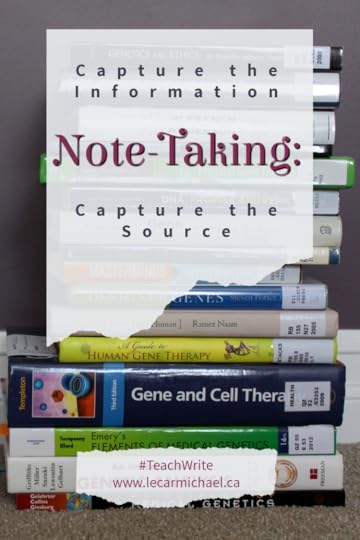 Welcome to Teach Write! This column draws on my 20 years’ experience teaching writing to kids, university students, and adult learners. It includes ideas and exercises that teachers and students can use in the classroom, and creative writers can use to level up their process.
Welcome to Teach Write! This column draws on my 20 years’ experience teaching writing to kids, university students, and adult learners. It includes ideas and exercises that teachers and students can use in the classroom, and creative writers can use to level up their process.
So far, our discussions of research have focused on how to find interesting, relevant information for our writing projects. Now we’re going to look at a skill that’s equally important, but less-commonly discussed: how to manage and organize all of that information so that you can find it when you need it.
Over the last couple decades, I’ve honed my own data management process for maximum ease and efficiency. With the methods I’ll be sharing with you over the next few columns, I researched and wrote the 15,000-word Forensic Science: In Pursuit of Justice in just six weeks… and I’m keeping track of over 300 sources for my current work-in-progress (coming 2023!).
So let’s get started with today’s topic: note-taking. The goals of note-taking are simple:
to capture important informationto capture the source of the informationDo both, or you’re asking for trouble.
Capturing InformationI took notes for my very first books the way I’d done it as a student: by hand, in a paper notebook. By the end of that project, I knew I needed to find a better way. Handwriting was slow, messy, and caused a brutal flare-up of wrist pain. These days, I type all of my notes directly into a Scrivener file (more on that in a future column). The advantages of typing notes are:
Typing is faster than writingIt spreads the labour more evenly between your hands, so less repetitive-strain injuryIt’s taking notes and transcribing notes all in oneWhen it’s time to draft, you can copy and paste typed notes to create a quick and dirty outlineLast year, I splurged on a second monitor for my desktop computer. If that option is available to you, I highly recommend it. I open a website or PDF on the left screen and type my notes into a document on the right screen. The ability to see bigger windows, with larger print and fewer neck motions, is both faster and less painful than squinting down at tiny printed type. I’m also printing fewer pages. That’s not only good for the environment, it’s fewer teetering piles of physical documents I need to track and organize.
What information should go into your notes? Totally depends on the project. But as a general rule, I’d be sure to record:
Key concepts and definitionsSpecific numbers, data, and datesNames of expertsPithy quotes you might want to reproduceCapturing Source InformationRaise your hand if you’ve ever found yourself adding citations to a paper the night before it’s due, frantically flipping through pages of a deep stack of reference books because you’re SURE you read something SOMEWHERE, but have no idea WHERE.
Yeah, me too. It sucks.
Whether student writers or professionals, we need to know where every piece of info in our notes comes from, and we need to track source info as we go along. This is for our benefit, because it allows us to double check things or go back into our sources for more detail, as well as saving us HUGE amounts of time at the bibliography stage. It also gives us confidence in our research, so that if teachers or editors or fact checkers or cranky Amazon reviewers question our work, we can show our sources.
We’ll talk about software tools for tracking sources in future columns. For now, here are my top low-tech tips:
Start a separate file for every single source. Keeping notes from each source segregated in this way cuts down on confusion later.Tag EVERY SINGLE sentence or paragraph in your notes file with the author and year of your source, like so: {Smith, 2019} Isn’t that overkill, you say? I’ve already got the notes in their own file. Sure, you do NOW. But when it’s time to draft, you will probably be copying and pasting into a single file. Unless the individual facts are tagged, chaos will ensue.For print material and PDFs, add the page number to the tag, like so: {Smith, 2019@3} When you’re double checking or fact checking, this eliminates the need to flip pages or comb the index.For websites that don’t have pages, I usually note the paragraph number, for quick and easy scanning.It’s also really, really important to be clear about what’s a direct quote from your source, what’s a paraphrase, and what is you adding your own interpretations, commentary, or reminders to yourself to look into things or compare to other sources. I use plain text for paraphrases and “quotation marks” when I’m transcribing the exact words used in my source. I indicate commentary with brackets and my initials, like this: (not so sure this is accurate, double check – LEC). Your mileage may vary here, and it really doesn’t matter how you do it, so long as you know what’s what.
After all, you don’t want to accidentally plagiarize because you’ve forgotten that a sentence of notes was not a paraphrase, but a direct quote. And you definitely don’t want to attribute your own genius insights to another author!
Bonus Tip: File ManagementIn the digital age, you’ll be balancing a lot of PDF source files, in addition to your notes files. Descriptive file names will prevent you from having to repeatedly open things to see what they are – save time by renaming stuff right away. I like to use author’s name and year: Smith 2019.pdf or Smith 2019 notes.docx
To make it quicker to find material on a particular subtopic, I sort my files into folders. For my current project, I’ve got folders for birds, mammals, and fish, with subfiles for information on particular species: Mammals – Lynx.
Keeping your digital filing cabinet organized as you go will save a lot of headaches later.
Next time, go pro with reference managers! Until then, share your own note-taking tips and experiences in the comments.
Hey, did you know I teach writing workshops? It’s true – I work with adult writers, teachers, and students of all ages. Contact me to learn more.
January 22, 2021
Yellow Cedar Book Talks: It Began With a Page
The Boreal Forest: A Year in the World’s Largest Land Biome, has been nominated for a Yellow Cedar Award in the 2021 Forest of Reading! I am both thrilled and honoured to be in such great company, so I’ve created a series of video book talks to celebrate the work of my fellow nonfiction kidlit authors and – hopefully – to inspire readers like you to discover their work.
Today, we’re discussing It Began With a Page: How Gyo Fujikawa Drew the Way, by Kyo Maclear, illustrated by Julie Morstad. Enjoy!
The Forest of Reading is a children’s choice award program that’s open to schools, libraries, and individual families. For more information on how to participate, visit the Registration page.
January 15, 2021
Erin Silver: Writing About the Pandemic During the Pandemic
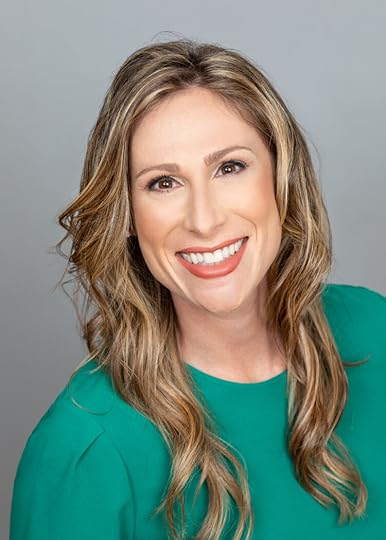 Welcome to Cantastic Authorpalooza, featuring posts by and about great Canadian children’s book creators! Today’s guest: Erin Silver
. Take it away, Erin!
Welcome to Cantastic Authorpalooza, featuring posts by and about great Canadian children’s book creators! Today’s guest: Erin Silver
. Take it away, Erin!
I’d been working really hard on my first-ever children’s book and was so excited for it’s spring 2020 release. Called Proud to Play, it’s about the experience of Canadian LGBTQ athletes in professional sports. The topic was so important and I’d poured my heart into writing and researching the book. But then the coronavirus starting spreading. The Olympics were postponed. Even sports clubs for kids were cancelled. And then, my book was put on hold, too.
Suddenly, I was at home, miserable over the derailment of my writing career, while trying to help my kids learn online, while also refereeing their fights, while trying to maintain my six feet of distance while walking my dog, which was pretty much the only activity you could do when Toronto went into lockdown. I know, I’ve painted a pretty bleak picture of how I was feeling in spring of last year, but looking back, it was an accurate one.
I took a deep breath and decided not to give up. After all, I’d been working on several other manuscripts and proposals. Why not send them out and touch base with publishers and editors since there wasn’t much else I could do? Unfortunately, they all said the same thing: everything had changed because of the pandemic. None of the ideas I’d been pitching were relevant considering the uncertain future of the publishing industry, and the world, for that matter.
One day, I happened to be emailing with an editor from Second Story Press. She also didn’t want the manuscript I’d been pitching, but she asked if I was interested in writing a book about how kids around the world were helping others during the pandemic. I jumped at the chance to take on a new writing project. Nothing makes me happier than having a purpose. And this felt meaningful. At a time when schools, libraries and offices were closed, when people were worried about everything from their health to their finances, this book would offer hope and inspiration.
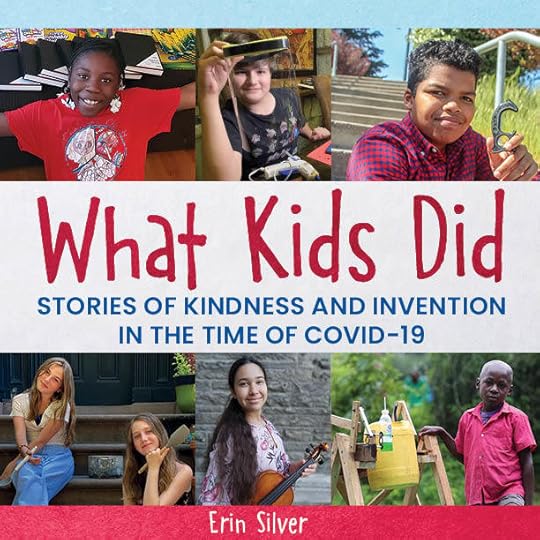 I dove in to my research—and I brought my husband with me. I was overwhelmed by the scope of the project and needed help. Together, we scoured the internet, typing in different search terms, scanning social media, blogs and newspapers in languages we didn’t even understand. Each time we found a good-news story about a child who had helped others, we felt uplifted ourselves. It was amazing to see how kids, some as young as six, were taking action and making an impact at a time when even adults were paralyzed by fear.
I dove in to my research—and I brought my husband with me. I was overwhelmed by the scope of the project and needed help. Together, we scoured the internet, typing in different search terms, scanning social media, blogs and newspapers in languages we didn’t even understand. Each time we found a good-news story about a child who had helped others, we felt uplifted ourselves. It was amazing to see how kids, some as young as six, were taking action and making an impact at a time when even adults were paralyzed by fear.
I had one month to find stories from across the globe, track down parents, conduct interviews, and write a picture book that would empower kids to make a difference, too. The book features sisters who started a good-news-only broadcast, a boy in Japan who created a graduation ceremony on Minecraft so all his friends could celebrate, and a boy in Kenya who built a semi-automatic hand-washing stand so people in his village could wash their hands more safely. Called What Kids Did: Stories of Kindness and Invention in the Time of COVID-19, the book was released in October 2020. I was so proud of the more than 25 stories that ended up in the book and was buoyed by all the other stories I’d found during my research.
When the first box of printed copies arrived at my door, I was elated. I wrote personalized notes and mailed each kid in the book a copy. When they received it, many of them emailed me photos of themselves holding the book. Connecting with people around the world, by email and mail, was one of the many highlights of writing a book about the pandemic during the pandemic.
Another highlight? Interacting with kids during virtual author visits. After the book’s release, I reached out to teachers I knew, and some I didn’t, to tell them about the book and to offer to meet their classes online to discuss the book. These visits were fun and energizing. Students were eager to talk about the book and to tell me about how their lives had changed during the pandemic. They asked me about the kids in the book and life as an author. Some even wrote me notes afterward to tell me how much the book had inspired them. I haven’t met these kids personally—and who knows when in-person author visits will happen again—but I will always treasure their kind words.
None of this has been easy, not for anyone. But writing about the pandemic in a pandemic has taught me: never give up hope.
Erin Silver is a children’s author in Toronto. Her middle grade novel, Just Watch Me, was released in October 2020 by Common Deer Press. What Kids Did: Stories of Kindness and Invention in the Time of COVID-19, was published by Second Story Press in October 2020 as well. For more about Erin or her books, visit her online at erinsilver.ca.
January 8, 2021
Yellow Cedar Book Talks: Crows: Genius Birds
*Peeks out from under blanket fort*
*Decides it might be safe to emerge*
*Checks the news, changes mind*
Hello, 2021. We are off to a rocky, rocky start, which means we could all use the escape of a good book right now. And I am here to help.
The Boreal Forest: A Year in the World’s Largest Land Biome, has been nominated for a Yellow Cedar Award in the 2021 Forest of Reading! I am both thrilled and honoured to be in such great company, so I’ve created a series of video book talks to celebrate the work of my fellow nonfiction kidlit authors and – hopefully – to inspire readers like you to discover their work.
We’re kicking off the series today with Crows: Genius Birds, by Kyla Vanderklugt. Enjoy!
The Forest of Reading is a children’s choice award program that’s open to schools, libraries, and individual families. For more information on how to participate, visit the Registration page.
December 21, 2020
What Three Things Make You Truly Happy?
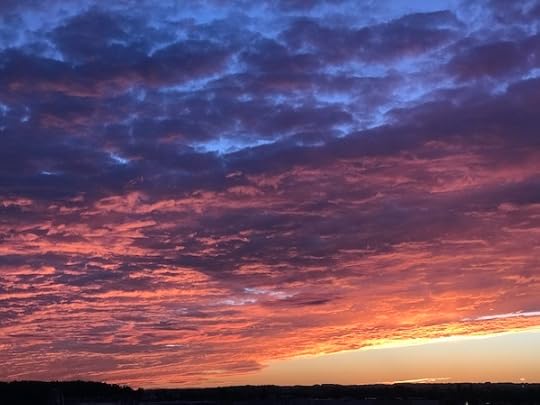 It’s mid-December, and you know what that means: New Year’s Resolutions are just around the corner.
It’s mid-December, and you know what that means: New Year’s Resolutions are just around the corner.
I’ll be honest. I’ve never found classic resolutions particularly helpful. In fact, they’re more likely to produce feelings of guilt and inadequacy than happiness and accomplishment. If you’re with me on this, you might want to try something else instead:
Identifying Your Top Three Things
I’ll explain, but first, credit where it’s due: I did not invent the concept of the Top Three Things. I first heard about it several years ago, from from one of my Sisters of the Traveling Chocolate (where she got it, I have no idea).
So What Are the Three Things?
These are the things that give you joy, that light you up, that make you who you are… things so fundamental to your personality that you can’t be truly happy without them in your life.
Note that the three things are not about you-in-relation-to-other-people. “Being a good mom” is a worthy goal and might be really important to you. But your Three Things are the things you would want for yourself, even if you weren’t a mom.
As my friend explained that long ago day on the phone, her Top Three Things are:
expressing her creativity
being physically active
being outdoors
As long as her life includes these things on a regular basis, she’s happy. What things made me happy, she wanted to know?
I’d never really thought about my life this way before, but off the top of my head, I said:
expressing my creativity
learning new things
getting lost in a good story
Funnily enough, our lists both reveal why we are friends and why, when we were younger, she wanted to go for bike rides and I wanted to watch movies…
But here’s something I learned just recently:
Your Three Things Might Change Over Time
About a year after we moved from Nova Scotia to Ontario, I realized two things:
I was now a full-time writer, and
something was missing.
Since I’ve wanted to be a full-time writer since I was about 1o years old, that second one was unexpected, to say the least. So I did some thinking and journalling and I realized that what I was missing was teaching and mentoring – two things I’d done a lot of while working at SMU in Halifax. And then I realized that my Top Three Things weren’t what I’d thought they were. My REAL Top Three Things, the things I need to do in order to be my most authentic self, are, quite simply:
to learn
to teach
to create
And that was the revelation that not only allowed me to identify what was missing in my life, but to figure out how to get it. I’ve been a lot happier ever since.
This New Year’s, I challenge you to skip the resolutions. Identify your Top Three Things and figure out how to bring them into your life. It might just be the path to true and lasting happiness.
Happy Holidays, everyone. See you on the other side.
December 14, 2020
Carol Matas: Science, Science Fiction, and The Big Questions
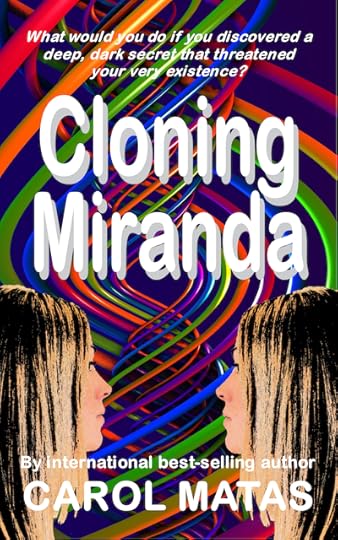 Welcome to Cantastic Authorpalooza, featuring posts by and about great Canadian children’s writers! Today’s guest:
Carol Matas
. Take it away, Carol!
Welcome to Cantastic Authorpalooza, featuring posts by and about great Canadian children’s writers! Today’s guest:
Carol Matas
. Take it away, Carol!
I love writing science fiction.
My very first four books were science fiction: time travel dystopian novels about climate change, corporations taking over the world, false prophets and utopias. Hmm. That was 33 years ago! Seems like I was either a prophet or nothing has changed. Obviously, it’s the latter.
Because those books are still relevant, I reworked them and updated them and they were republished as The Edge Of When a number of years ago.
I decided to do the same thing with Cloning Miranda, The Second Clone and The Dark Clone. A few years ago it seemed to me that these books, recently out of print, were as relevant today as they were in 1999 when first published. The science of cloning has taken a huge leap forward since the initial publication with the development of gene CRISPR technology and I was able to update accordingly. And I was able to further explore the questions that the science raises.
Is Cloning Miranda about the dangers of cloning? Most certainly. But it is also a meditation on what makes us human and what it means to be a human being. Is nature the biggest factor in our development or is nurture? How do we make choices? Are we preprogrammed to make certain decisions because of the way we were brought up, or are we preprogrammed to make certain decisions because of our genetic makeup? Can we make free choices or do we live in a prison of our own minds, a prison composed of both our upbringing and our genes?
Perhaps this is a good time to mention my own inspirations for writing science fiction. I think the first and most important writer who influenced me was Frank L. Baum, the author of The Wizard Of Oz series. In Dorothy he created a brave young girl who had a deep empathy for others, as well as a matter-of-fact acceptance of danger and the exotic, such as lunch boxes that grew on trees or flying monkeys – whole new worlds described with love and wit. And then, of course, when I was older, Star Trek. I must have watched every episode three or four times: again, whole new worlds created with warmth and with hope. I must also add Ursula Le Guin, Doris Lessing, and Marion Zimmer Bradley as favourites, and as writers that influenced me because of the way they blended storytelling with themes and issues that made me think beyond my usual parameters.
The stories and the science and the futuristic settings in science fiction make a perfect backdrop to explore what I like to call The Big Questions. Young readers, I believe, are as interested in The Big Questions as adults are. Perhaps more so, because they are in the process of deciding their futures.
The science in science fiction is important too, don’t get me wrong. Firstly, it needs to be accurate, so time must be spent researching, reading and then fact checking. Interestingly, the science can lead you down certain paths in your storytelling. A similar thing happens when you research historical fiction. Often the facts and the history will lead your characters somewhere surprising or open up new ideas that hadn’t even occurred to you. It all works together – hopefully – to create an organic whole.
At any rate, Cloning Miranda is that mix of scientific discovery, speculation, and fiction, woven together to, perhaps, encourage people of any age to think about things slightly differently, and to expand their horizons.
December 7, 2020
Research for Writers: How to Interview an Expert
Welcome to Teach Write! This column draws on my 20 years’ experience teaching writing to kids, university students, and adult learners. It includes ideas and exercises that teachers and students can use in the classroom, and creative writers can use to level up their process.
Sooner or later, every writer is going to have to interview an expert. Students might be required to do so for an assignment; for creative writers, interviews are sources of stories, anecdotes, quotes, and details that can’t be gleaned from any other type of source. This is particularly true for STEM topics, where the convention is for experts to strip every bit of colour and personality out of their written work… meaning, there’s a TON of brilliant stuff they didn’t put into their papers, but will tell you about if you ask.
As writers, we know that doing an interview is a good idea… but for most of us, interviews are terrifying. What introvert wants to cold call a total stranger and ask for a favour? But we have to get over this fear, so that we can access the best possible material for our manuscripts.
I’m in a unique position when it comes to interviews. As a writer, I’ve interviewed experts. But as a scientist, I’ve also been interviewed by writers – both students AND professionals. I’m going to share my best tips from both sides of the fence.
First things first?
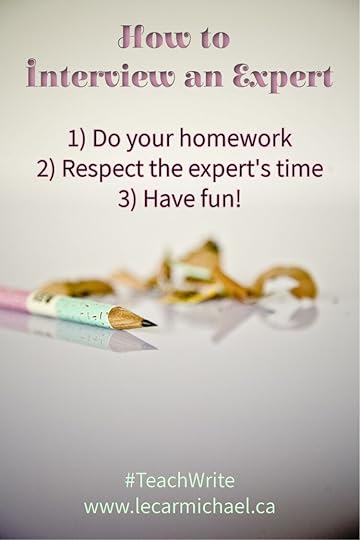 Do Your Homework
Do Your HomeworkAlways remember that the person you’ll be interviewing is doing you a favour. They are giving you the gift of their hard-won expertise, not to mention valuable time out of their very busy schedules. Respect that time.
Back in my days as a wildlife geneticist, I received an email from a student at another university asking me to send him a list of books and papers that he could read to learn more about wolves. I was so irritated that this person had contacted me without ever setting foot in a library, I didn’t bother to respond.
Don’t expect an expert to teach you basic concepts or provide information you could access yourself with a few hours’ research. Instead, contact an expert when:
the sources you’ve been reading are contradictory, and you need clarification
you’re looking for a very specific piece of information that you haven’t been able to dig up on your own
you want the kind of first-hand, personal, emotional detail that only someone who’s lived your topic can provide
Once you’ve done the leg work…
Understand That Most Experts Are Happy to Share Their Stories
In fact, most people are so astonished that someone cares enough about what they do to write about it, they will bend over backward to help you. This is particularly true of scientists, who are used to feeling like they are the only person on Earth who cares about the thing they’ve devoted their entire life to studying!
True story: when I was working on Fuzzy Forensics, I wanted to interview a wildlife officer and a veterinarian who’d been involved in investigating a case I was covering. I googled for contact information and discovered that both men had passed away in the years since the investigation. But to write the book the way it needed to be written, I needed information about them, even if I couldn’t speak directly to them about their experiences.
In a cold sweat, I cold called their widows. To my relief and delight, both women were absolutely thrilled that someone remembered their loved ones and wanted to honour their work in print. They told me stories, sent me photos, and, after the book was published, bought copies for all their friends and family. I was so overwhelmed by that outpouring of support, I ended up dedicating the book to my experts’ memories.
Yes, there will be an occasional expert who doesn’t respond to your emails, but there is almost always someone else working in the same field that you can try. In fact, some experts will tell you they are too busy but refer you to colleagues who can help.
Asking For An Interview
Protocol here varies a little bit depending on the type of expert, the contact info you’ve found, and what you need.
If my first contact with someone is via email, I start by:
Introducing myself as a writer and very briefly describing what I’m working on: “I’m a Canadian children’s writer working on a book about the boreal forest.”
Explaining why I’m contacting this person, instead of someone else: “I’ve read your fascinating papers…”
Then, I do one of two things:
Ask the one question I’ve got. “I’m having trouble finding out how long it takes for leaf litter to decompose, can you help?”
Ask if the expert is open to an interview.
When asking for an interview, I make sure to mention:
That I’m open to email, phone, zoom, in person…. generally according to the expert’s preferences and schedule
The approximate number of questions or, in the case of a phone call or live interview, roughly how much time I will need.
Again, this is all about demonstrating that I’ve done my homework first and respecting the expert’s time. Speaking of which…
If your first contact with your expert will be by phone, which is much more intrusive, do not expect the expert to drop everything and answer questions at that moment. Explain that you are calling to request an interview at a time that’s convenient for them. You’re much more likely to get a yes that way.
Composing Your Questions
Yes/no questions are fine, but you’re not going to get the good stuff with them. Open-ended questions such as “What’s the most amazing thing that’s ever happened to you while hiking in the Rockies?” encourage the expert to tell you a story… and that’s where the colour and detail are hiding.
When composing your questions, keep the audience for your writing in mind. The very first children’s article I ever sold is called “Bringing Up Baby Foxes” and is based on research I did as a scientist. The article was published in Highlights for Children, a magazine that loves quotes from experts, so I interviewed one of my coworkers for it. As I was writing my questions, I realized that they were geared towards producing information I already knew, just in someone else’s voice. And then I realized that this was my chance, as a lab-based scientist, to ask a field researcher something I’d always wondered about – what’s it actually like to touch a real, live, wild arctic fox! I asked, and I’m so glad that I did. Not only did I satisfy my own curiosity, but I captured details about fox behaviour and the texture of fox fur that the average 8-year-old would – and did – absolutely love.
During the Interview
If you’re doing a live or phone interview, take notes, and flesh them out as soon as the interview is over, while everything is still fresh in your memory. And do not record someone without asking their permission first.
Follow your script, but don’t be afraid to deviate if the expert mentions something fascinating you never thought to ask.
Likewise, at the end of the interview, ask something like “Is there anything that I forgot to ask that’s important for people to know?” There is usually some pet peeve or misunderstanding about their field that the expert would love to correct. If not, there might be something else that’s super cool that the expert is just dying to share. It’s not uncommon for this question to be the most fruitful of the interview.
Stick to your budget. If you said you’d need 30 minutes, don’t take 60. Respect the expert’s time.
Finish by thanking the expert and asking whether you can follow up with them, should something come up while you’re writing. Also, offer to send them a copy of whatever you’re working on when it’s published.
And finally…
Remember that you have two goals:
to get information for whatever you’re writing
to make a contact that you can return to for help in the future.
That second one will only happen if you are professional, respectful, and express your gratitude for the gifts the expert has given you, but if it does, it will enrich your writing life for years to come.
Hopefully, you’re feeling a little less frightened and a little more prepared to go forth and interview! In the meantime, shoot me your questions in the comments, and feel free to share your own experiences interviewing experts.
November 30, 2020
How to Stop Apologizing for Your Own Accomplishments
Me and the other winners of the 2014 Lane Anderson Award. Photo taken by Emma McIntyre.
Welcome to STEMinism Sunday! As a former woman in science, I have a deep and enduring interest in the experiences and representation of women in STEM fields (science, technology, engineering, and math). This series will be an opportunity for me – and you – to learn more about these intellectual badasses.
Two things you might not have known about me:
We moved around a LOT when I was young, so I was the new kid right up until high school.
I was a gifted kid who learned quickly and tested very, very well.
In combination, these things are kid kryptonite. NO ONE likes the kid who moves to town and is suddenly at the top of the class (especially that kid who was at the top of the class a hot second before).
Bullying ensued. It sucked.
It also taught me that if I wanted to survive, I was going to have to find some defensive mechanisms right quick. I developed a two-pronged strategy:
Never tell anyone what I “got” on a test or assignment. This worked much better after teachers stopped reading everyone’s marks out loud. Seriously, teachers – never, ever do that to your class. Except for those kids comfortably in the middle, it is THE WORST.
Deflect and downplay.
I stopped raising my hand in class, answering a question only if the teacher specifically asked me to (and avoiding eye contact so they’d ask less often). I avoided leadership roles or any activities that would draw attention to me, and tried to stand in the back whenever I could. If someone said, “Great job on that test,” I wouldn’t say thanks, I’d say, “I got lucky.” If someone said, “You’re really smart,” I’d say, “No, I just studied really hard – you could do it, too.”
I thought that by doing this, I’d protect myself from negative attention. If it was true that “They only tease you because they are jealous”* maybe the secret was not giving them a reason to be jealous.** It… only sort of worked (finding really good friends worked better – there’s protection in numbers).
I also thought that, by downplaying my achievements, I’d make other people feel better about themselves. I didn’t realize it at the time, but what I was actually doing was making myself feel worse. By telling people that anyone could do what I had done, I robbed myself of the right to feel proud of what I’d accomplished.
It’s only recently that I’ve realized I am still doing this – telling myself that my successes are accidental, or coincidental, or just not that big a deal. I’m uncomfortable taking pride in my hard work or celebrating my own “wins.” That sentence in the intro where I described myself as a gifted kid? I had to re-write it four times before I could convince myself that it was OK to use the word “gifted” without scare quotes.
I am not alone in my fear of drawing attention to myself. Women in STEM – and other academic fields, and in society in general – are taught to be quiet, to take up less space in the room, and to never make anyone else uncomfortable. This not only makes it harder for us to succeed, but harder for us to own our success – to feel joy and pride and satisfaction in our work. The joy and pride and satisfaction we’ve legitimately earned.
So how do we learn to stop apologizing for our success?
Here are some things that I’m personally working on, with varying degrees of success:
Recognizing that I’ve been lying to myself and everyone else for years. It’s not actually true that anyone could do the things I’ve done. Yes, I really am incredibly lucky – blessed with good genes and parents who had the means to provide me with books and educational opportunities. But I also work really, really hard. And while I can’t take credit for the good genes or the privileged upbringing, I can take credit for the work ethic. That’s mine, and the products of that work ethic are mine, too, no apologies necessary.
Recognizing that there’s a difference between giving credit where it’s due and giving away ALL the credit.
Recognizing that there’s a difference between unearned arrogance and justifiable pride.
Recognizing that, while it IS my responsibility be kind, I CANNOT be responsible for someone else’s happiness or self-esteem.
Recognizing that, while other people might not be able to do what I can do, they can do AMAZEBALLS things that I could never do. And cheering for their accomplishments makes me feel better about cheering for my own.
I’ve shared this in the hopes that it will help other women who are struggling with the same issues. But I’d really like your help, too. How have you learned to stop apologizing for your accomplishments? No really, I’m asking. I’m all ears. 
November 23, 2020
Erin Mercer: When Reference Doesn’t Come Easily
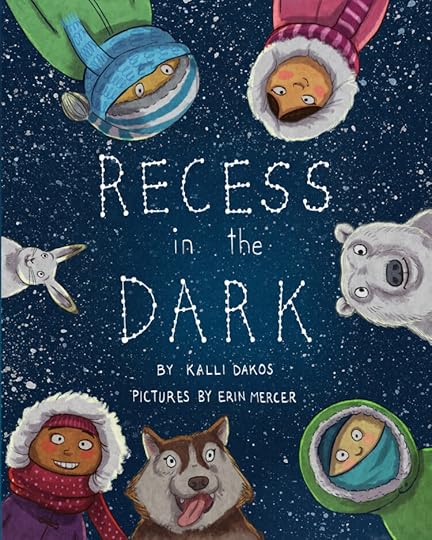 Welcome to Cantastic Authorpalooza, featuring posts by and about great Canadian children’s book creators! Today’s guest: illustrator
Erin Mercer
. Take it away, Erin!
Welcome to Cantastic Authorpalooza, featuring posts by and about great Canadian children’s book creators! Today’s guest: illustrator
Erin Mercer
. Take it away, Erin!
Now and then illustrators get projects that aren’t straightforward, and not only challenge our technical skills but also our ability to research. I was thrilled when I signed my first illustration contract for a children’s poetry book titled “Recess in the Dark.” The poems follow the children’s perspectives on the playgrounds of the Northern Territories of Canada where they play in pure darkness during winter months.
Many pages focused on the northern lights, whose highlighter pinks, acidic green-yellows, lavender purples, and Caribbean turquoises are definitely not printer friendly! I was also met with the difficulty of having to portray night without the pages being too dark. These challenges were solved with my knowledge of colour theory, but something strange happened when my rough sketches needed detail – I couldn’t find visual references easily. 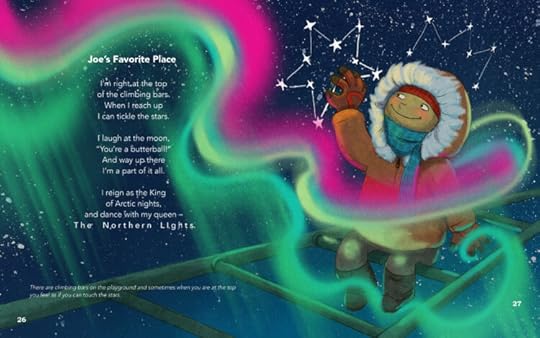
Illustrating accurately truly means you have to embrace becoming an autodidact. With a short 5 month deadline, I finished the project after an immense amount of research.
When I start an illustration, I’m on the hunt for a mood. I like to look at a combination of historic paintings, contemporary paintings, illustrators and photos for inspiration. I looked to the Group of Seven and William Kurelek for winter paintings and a contemporary American painter, Steve Atkinson, for his nighttime scenes. I also referenced one of my favourite children’s book illustrators, Will Terry, as he beautifully depicts vibrant winter scenes.
All of these artists gave me inspiration for the palettes I chose. The saturated blues and periwinkles read as snow at night, so I let those shine in my illustrations.
Having grown up in Ontario, Canada, I felt a connection to my own childhood winter memories: climbing gigantic snow mounds, building snow animals with my mom, trudging through fresh snow, being pulled on a toboggan by my dad in the countryside, and making snow angels. I added many of these personal moments throughout the pages.
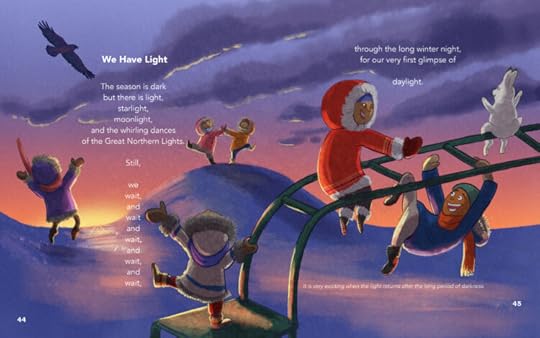
To learn about the terrain, wildlife, culture and history, I took out grade school books on the Canadian Territories. Over half of the Canadian North is above the treeline with rocky terrain and little plant life. These details are never mentioned in the manuscript but were absolutely critical for an accurate depiction of the North. Since I couldn’t visit the location in person, the National Film Board was another tremendous resource. One poem titled “An Igloo” was particularly challenging to depict realistically, but I found footage in the NFB archives of an igloo being built from start to finish.
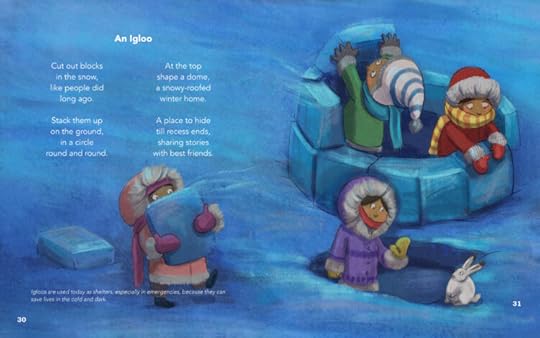
Other clips in their archives showed contemporary Iqaluit terrain and dog sledding teams, an exciting topic in a couple of the poems. Since film footage captures the energy of a moment, it’s more valuable than a static image as it’s the closest thing to witnessing an event in person.
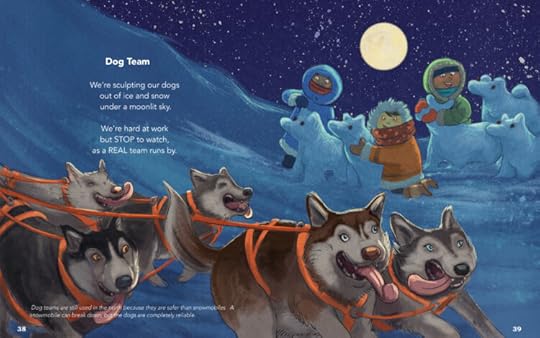
When I’m refining my paintings and require accurate details, often I’ll reference Pinterest boards or Google image search to find the photo reference I need. We’ve all seen the recent trends of perfectly staged photos and the illusion of perfect lives. Playing in the pitch dark when it’s -30C isn’t a fairy tale, so I had to use my art skills to combine my new visual knowledge of the North with the poems.
I ended up combining reference photos of Iqaluit playgrounds during the day with winter landscape photos. Most winter landscapes depict billowy trees heavy with snow, so instead, I referenced how moonlight shines on crusty snow caps and the colour of snow in shadows.
It was extremely challenging finding images and descriptions of how children up North dress. There are many historic photos of First Nations and Inuit families in traditional and ceremonial wear, but it was almost impossible to find current images. I relied on the author’s first-hand experience and the few images she had from her time teaching up North. Mother Hubbard coats, fur lined boots and rabbit skin mittens are more common than the brightly coloured, synthetic, puffy jackets I was used to in Southern Ontario.
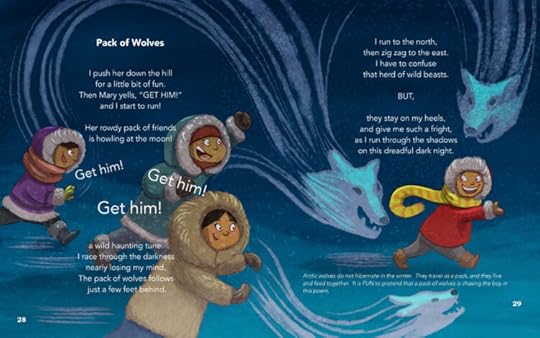
Illustrators have come a long way from having to rely solely on the written word. A part of our own lived experience is in our illustrations, just like the author’s are in the text. But to live up to honouring reality, sometimes a stack of library books, masters’ oil paintings, and video footage are the most invaluable resources. Reference doesn’t always come easy, but it’s always worth the effort.
Recess In The Dark was written by Kalli Dakos and published by DC Canada Education Publishing.
November 16, 2020
Pompeii: Ghosts, Curses, and Brains of Glass
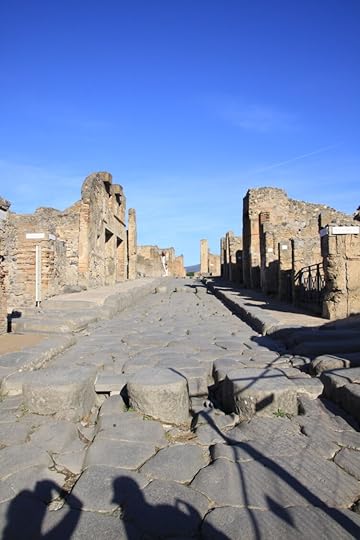 Last fall, I was lucky enough to visit the ruins of Pompeii. October not withstanding, it was a hot, sunny day, even first thing in the morning when our tour group arrived. In the distance, the green slopes of Mount Vesuvius rose against the sky: lush, serene, and bearing absolutely no resemblance to the flaming monster that destroyed the city – and several others – in 79 AD.
Last fall, I was lucky enough to visit the ruins of Pompeii. October not withstanding, it was a hot, sunny day, even first thing in the morning when our tour group arrived. In the distance, the green slopes of Mount Vesuvius rose against the sky: lush, serene, and bearing absolutely no resemblance to the flaming monster that destroyed the city – and several others – in 79 AD.
It’s a singularly eerie place.
At that time of day, the ruins were all but abandoned – just a few hundred tourists scattered across what was once a bustling metropolis. There were too few people in too much space. And there were scars of utter devastation right next to buildings that were perfectly preserved, as if waiting through the long centuries for their inhabitants to return.
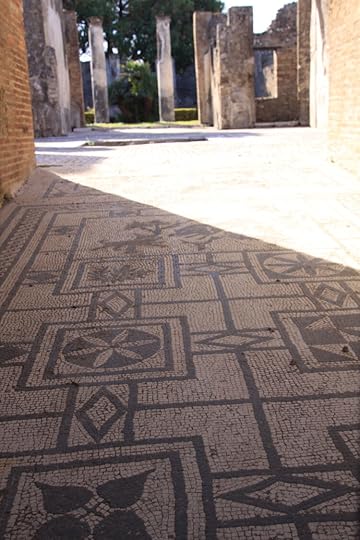 Small wonder that some people consider Pompeii to be cursed. In fact, more than a hundred tourists who’d once made off with tiles, stones, or other pilfered relics have since mailed them back, blaming the stolen objects for all that’s since gone wrong in their lives. As Global News reported last month, some of those unfortunate tourists were Canadian.
Small wonder that some people consider Pompeii to be cursed. In fact, more than a hundred tourists who’d once made off with tiles, stones, or other pilfered relics have since mailed them back, blaming the stolen objects for all that’s since gone wrong in their lives. As Global News reported last month, some of those unfortunate tourists were Canadian.
In case you’re wondering, no, I’m not among those cursed visitors. I was sufficiently haunted by the experience of being herded past the remains of one of Pompeii’s victims, with enough time to snap a photograph but not enough to pause for a moment in respect. Italian tour guides are militant about their schedules, and I felt rather ghoulish as a result of this unseemly haste. No way would I compound the insult by making off with a sketchy souvenir!
It was the memory, perhaps, of that huddled body, that made recent discoveries so fascinating to me. Or maybe not. Let’s be honest, this science is so weird, so cool, so – dare I say it? mad – that I probably would have found it fascinating no matter what. Because Italian researchers have discovered a Vesuvius victim in nearby Herculaneum whose brain had turned to glass.
The working theory is that the poor fellow’s skull was flash-heated by the volcanic blast, liquifying his brain tissues, which crystallized as they cooled. That is… not a thing we knew human bodies could do.
Increasing the “oh wow” factor? Follow up research using electron microscopy has revealed that the structure of some of the man’s neurons – some of his actual brain cells – was preserved during the process. CNN has a photograph, and it is amazing.
Imagine if the man’s last thoughts were also preserved in these fragile cells – echoes of what must have been a terrifying, if blessedly brief final moment. Would he have cursed the same gods that light-fingered tourists to Pompeii believe have cursed them?
Little wonder that the streets of the city feel less empty than echoing… echoing with the voices of Vesuvius’ ghosts.
